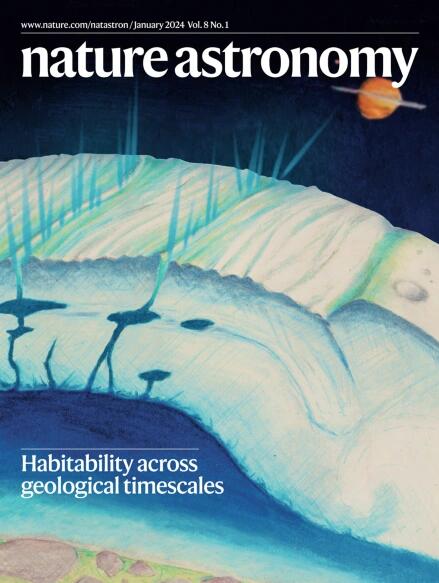冷流团簇中细丝的h α - x射线表面亮度相关性研究
IF 12.9
1区 物理与天体物理
Q1 ASTRONOMY & ASTROPHYSICS
引用次数: 0
摘要
冷流星系团中的大质量星系显示出来自活动星系核(agn)反馈的清晰证据。联合x射线和射电观测表明,AGN射电喷流将周围的热气体推到一边,并在热簇内介质(ICM)中形成空腔。这些系统拥有复杂的、千秒差距规模的多相丝状结构,从热和电离(10,000 K)到冷和分子(<100 K)。这些引人注目的块状细丝被认为是热ICM热不稳定冷却的自然结果,可能是由反馈过程触发的,同时通过混沌冷吸积(CCA)为AGN提供食物。然而,细丝形成机制的详细约束仍然不确定,不同气相之间的联系必须完全揭示。通过利用7个x射线亮冷流星团的样本,我们发现了细丝的x射线表面亮度与Hα表面亮度之间的紧密正相关关系,超过两个数量级,在剥离尾中也发现了这一点。通过利用流体动力学模拟,我们进一步展示了这种关系与CCA预测的定量一致性。这一发现为热丝和暖丝之间的共同激发机制提供了证据,其中由AGN反馈触发的多相冷凝驱动了它们紧密的共同进化。本文章由计算机程序翻译,如有差异,请以英文原文为准。


An Hα–X-ray surface-brightness correlation for filaments in cooling-flow clusters
Massive galaxies in cooling-flow clusters display clear evidence of feedback from active galactic nuclei (AGNs). Joint X-ray and radio observations have shown that AGN radio jets push aside the surrounding hot gas and form cavities in the hot intracluster medium (ICM). These systems host complex, kiloparsec-scale, multiphase filamentary structures, from warm and ionized (10,000 K) to cold and molecular (<100 K). These striking clumpy filaments are believed to be a natural outcome of thermally unstable cooling from the hot ICM, probably triggered by feedback processes while contributing to feeding the AGN via chaotic cold accretion (CCA). However, the detailed constraints on the formation mechanism of the filaments are still uncertain, and the connection between the different gas phases has to be fully unveiled. By leveraging a sample of seven X-ray-bright cooling-flow clusters, we have discovered a tight positive correlation between the X-ray surface brightness and the Hα surface brightness of the filaments over two orders of magnitude, as also found in stripped tails. We further show the quantitative consistency of such a relation with CCA predictions by leveraging hydrodynamical simulations. This discovery provides evidence for a shared excitation mechanism between hot and warm filaments, where multiphase condensation, triggered by AGN feedback, drives their tight co-evolution. A strong positive correlation between the warm and hot phases of extended filaments in massive galaxies within cooling-flow clusters supports theoretical models of active galactic nucleus feedback as the origin of these multiphase structures.
求助全文
通过发布文献求助,成功后即可免费获取论文全文。
去求助
来源期刊

Nature Astronomy
Physics and Astronomy-Astronomy and Astrophysics
CiteScore
19.50
自引率
2.80%
发文量
252
期刊介绍:
Nature Astronomy, the oldest science, has played a significant role in the history of Nature. Throughout the years, pioneering discoveries such as the first quasar, exoplanet, and understanding of spiral nebulae have been reported in the journal. With the introduction of Nature Astronomy, the field now receives expanded coverage, welcoming research in astronomy, astrophysics, and planetary science. The primary objective is to encourage closer collaboration among researchers in these related areas.
Similar to other journals under the Nature brand, Nature Astronomy boasts a devoted team of professional editors, ensuring fairness and rigorous peer-review processes. The journal maintains high standards in copy-editing and production, ensuring timely publication and editorial independence.
In addition to original research, Nature Astronomy publishes a wide range of content, including Comments, Reviews, News and Views, Features, and Correspondence. This diverse collection covers various disciplines within astronomy and includes contributions from a diverse range of voices.
 求助内容:
求助内容: 应助结果提醒方式:
应助结果提醒方式:


